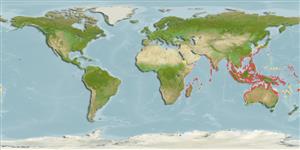Bivalvia |
Cardiida |
Donacidae
Environment: milieu / climate zone / ระดับความลึก / distribution range
นิเวศวิทยา
. Tropical
Indo-West Pacific: New Caledonia; north to southern Japan and south to New South Wales.
Length at first maturity / ขนาด / Weight / Age
วัยเจริญพันธุ์: Lm ? range ? - ? cm Max length : 2.5 cm SHL เพศผู้/กระเทย; (อ้างอิง 348); common length : 2.0 cm SHL เพศผู้/กระเทย; (อ้างอิง 348)
Intertidal, on sand and mud (Ref. 75840). On sandy beaches, in all but the most sheltered areas, often in dense populations. Most common in wave-beaten areas, migrating up and down the beach with the tide. Frequently preyed upon by crabs and birds during migration (Ref. 345). Confined on beaches with coarse, poorly-sorted sediments (Ref. 125508).
Life cycle and mating behavior
วัยเจริญพันธุ์ | การสืบพันธุ์ | การวางไข่ | Eggs | ความดกของไข่ | Larvae
Members of the class Bivalvia are mostly gonochoric, some are protandric hermaphrodites. Life cycle: Embryos develop into free-swimming trocophore larvae, succeeded by the bivalve veliger, resembling a miniature clam.
Poutiers, J.M. 1998 Bivalves. Acephala, Lamellibranchia, Pelecypoda. p. 123-362. In Carpenter, K. E. and V. H. Niem. 1998. FAO species identification guide for fishery purposes. The living marine resources of the Western Central Pacific. Volume 1. Seaweeds, corals, bivalves, and gastropods. Rome, FAO. (อ้างอิง 348)
IUCN Red List Status
(อ้างอิง 130435: Version 2025-1)
CITES status (อ้างอิง 108899)
Not Evaluated
CMS (อ้างอิง 116361)
Not Evaluated
Threat to humans
Harmless
Human uses
| FishSource |
เครื่องมือ
ข้อมูลเพิ่มเติม
นิเวศวิทยาเขตร้อนFood items (preys)องค์ประอบของอาหารการบริโภคอาหารผู้ล่า Life cycleการสืบพันธุ์วัยเจริญพันธุ์ความดกของไข่การวางไข่EggsEgg developmentLarvae Human RelatedStamps, coins, misc.
แหล่งที่มาจากอินเตอร์เน็ต
Estimates based on models
Preferred temperature
(Ref.
115969): 25.4 - 29.3, mean 28.6 (based on 2694 cells).
ความสามารถในการกลับคืนสู่ปกติ
ความสูง, เวลาต่ำสุดที่จะทำให้ประชากรเพิ่มขึ้นเป็น 2 เท่าใช้เวลาน้อยกว่า 15 เดือน (K=0.89-1.2).
Fishing Vulnerability
Low vulnerability (19 of 100).
